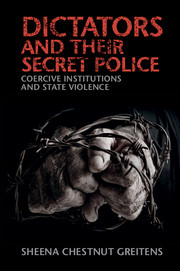Book contents
- Frontmatter
- Dedication
- Contents
- List of tables and fi gures
- A note on romanization
- Acknowledgments
- PART I THE PUZZLE AND THE ARGUMENT
- PART II THE ORIGINS OF COERCIVE INSTITUTIONS
- PART III COERCIVE INSTITUTIONS AND STATE VIOLENCE
- 6 Coercive institutions and repression in Taiwan
- 7 Coercive institutions and repression in the Philippines
- 8 Coercive institutions and repression in South Korea
- PART IV EXTENSIONS AND CONCLUSIONS
- Appendix: A note on sources
- Index
- Miscellaneous Endmatter
8 - Coercive institutions and repression in South Korea
from PART III - COERCIVE INSTITUTIONS AND STATE VIOLENCE
Published online by Cambridge University Press: 05 August 2016
- Frontmatter
- Dedication
- Contents
- List of tables and fi gures
- A note on romanization
- Acknowledgments
- PART I THE PUZZLE AND THE ARGUMENT
- PART II THE ORIGINS OF COERCIVE INSTITUTIONS
- PART III COERCIVE INSTITUTIONS AND STATE VIOLENCE
- 6 Coercive institutions and repression in Taiwan
- 7 Coercive institutions and repression in the Philippines
- 8 Coercive institutions and repression in South Korea
- PART IV EXTENSIONS AND CONCLUSIONS
- Appendix: A note on sources
- Index
- Miscellaneous Endmatter
Summary
The differences in the coercive apparatus under Park Chung Hee and Chun Doo Hwan, described in Chapter 5, shaped the patterns of state violence that Korean society experienced during their different periods of rule. The structure and social composition of the coercive apparatus in these two cases help us understand both the within-country temporal trends in levels of state violence, which were the main focus of the chapters on state violence in Taiwan and the Philippines (Chapters 6 and 7), and how the Korean cases compare cross-nationally, to the cases in the previous two chapters. Moreover, coercive institutional design can also shed light on sub-national variations in the execution of state violence, including cross-unit variations in state violence executed by different parts of the coercive apparatus and regional variations in the distribution of protest repression.
To a much greater degree than either Taiwan or the Philippines, the presence of an external threat in South Korea limited the degree of coup-proofing present in the coercive apparatus, particularly the externally focused military. By cross-national comparative standards, therefore, state violence in South Korea was relatively low. The non-military parts of the internal security apparatus, however, had important differences under Park, compared to Chun, that help to explain why violence in the two regimes took on a somewhat different character. Park's more fragmented and regionally exclusive regime engaged in intra-apparatus violence as organizations attempted to counterbalance and investigate each other, resulting in the arrest and sentencing of a number of internal security personnel. It also engaged in disproportionately high repressive violence against protests in Chŏlla, compared to the rest of the country, culminating in the Kwangju incident of May 1980. Chun Doo Hwan, on the other hand, had a unitary internal security apparatus but one that was divided in terms of exclusivity: somewhat more inclusive of Chŏlla at the top levels but entirely inclusive and representative in terms of its ground-level policing of protest. The difference in the social composition of Chun's riot police units helps explain several findings that are otherwise surprising and counterintuitive to scholars of Korea's authoritarian history: that in fact Chun seems to have been less violent on average in his non-protest repression than Park, that his repression of popular protest was usually less violent and less regionally biased, and that, despite these considerations, his use of repression ended up being far more reviled.
- Type
- Chapter
- Information
- Dictators and their Secret PoliceCoercive Institutions and State Violence, pp. 237 - 268Publisher: Cambridge University PressPrint publication year: 2016



